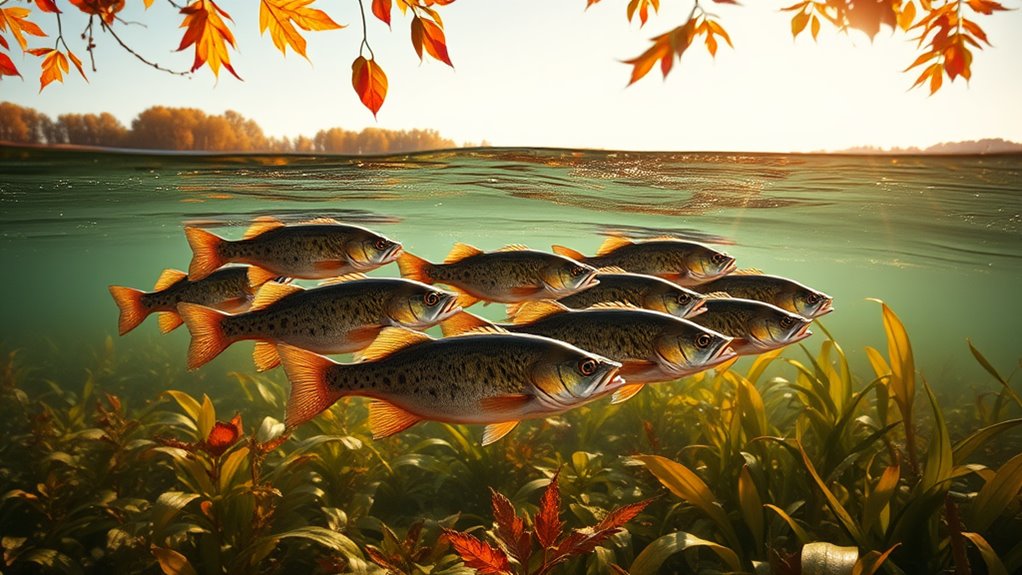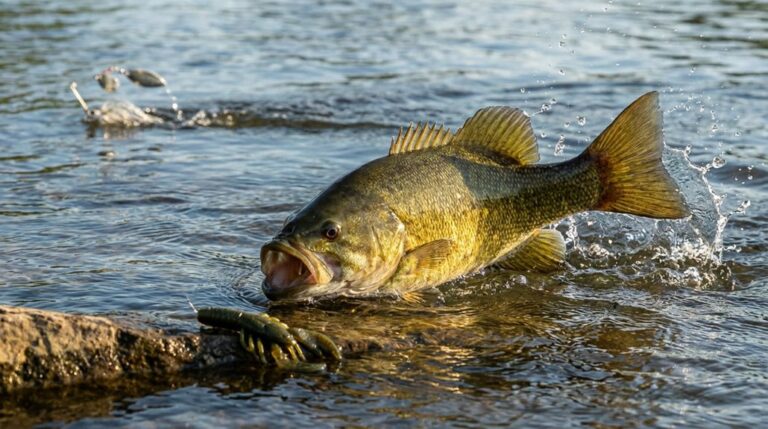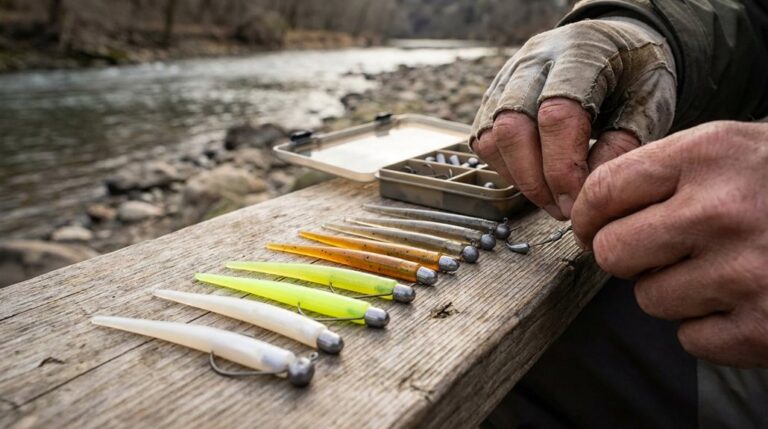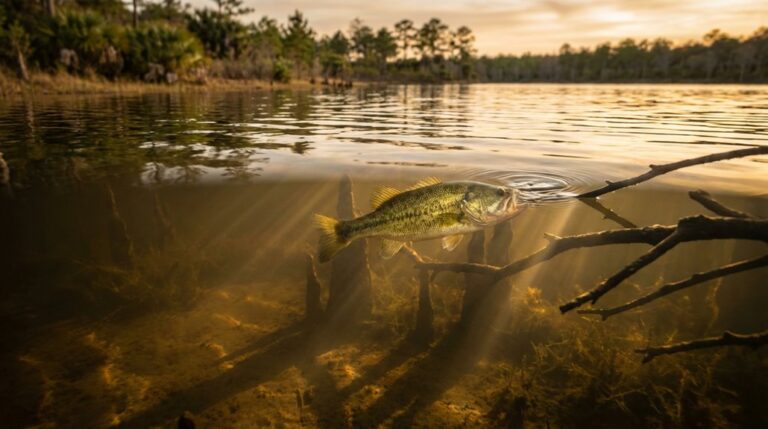You'll find spotted bass following predictable seasonal movements throughout the year. They spawn in spring when waters hit 63°F, move to 10-16 foot depths during summer, and push deeper to 20-30 feet in fall. Winter sees them schooling at depths up to 70 feet near structure. Each season requires different fishing techniques and bait selections, from spring's ringworms to winter's jigging spoons. Understanding these patterns will dramatically boost your success on the water.
Spring Migrations and Spawning Behaviors
As spring water temperatures climb to 63°F, spotted bass begin their annual spawning journey, with southern populations migrating in March-April and northern fish following suit in May-June.
During this spawning season, you'll find males selecting specific nesting sites along rocky banks and covered areas in the littoral zone. Their migratory behavior takes them from deeper waters to these shallow spawning grounds.
The males create shallow depressions where females deposit between 3,000 to 40,000 eggs during a 2-4 hour spawning process.
Habitat preferences play an essential role, as males guard these nesting sites vigilantly. They'll protect both eggs and fry while ensuring proper oxygen flow until hatching occurs within 2-6 days, depending on water temperatures.
As the fry mature, the fish gradually return to deeper waters.
Summer Deep-Water Strategies
When summer temperatures soar, spotted bass retreat to depths between 10 and 16 feet where they find cooler water and ideal oxygen levels.
During these summer months, you'll need to adjust your fishing strategy to target these deeper waters effectively.
Deep-diving crankbaits prove highly effective as they match the baitfish that spotted bass actively pursue. You'll want to downsize your baits to mirror their prey's size, as these fish become more selective feeders.
Despite their deep-water preferences, spotted bass display aggressive feeding behavior during early morning and late evening hours, creating prime opportunities for topwater action.
Don't overlook boat docks, where skipping worms and jigs can yield excellent results. These structures provide crucial shade and cover that spotted bass seek during the heat of summer. Additionally, observing seasonal patterns can enhance your chances of successfully locating and catching these fish during the summer months.
Fall Feeding Patterns and Movement

During fall's cooling pattern, spotted bass migrate to deeper sanctuary zones of 20 to 30 feet, particularly along bluff banks and creek channels where water temperatures hover around 50°F.
You'll find these fish concentrating around rock slides and gradual shorelines with abundant cover.
As the fall feeding patterns intensify, you can capitalize on their aggressive biting behavior when water temperatures dip into the low 50s.
You'll want to focus on main lake areas and creek channels, especially during the fall turnover period.
To maximize your success, target bait schools and adapt your fishing techniques accordingly.
Texas-rigged worms and jigs prove especially effective as the fish become more cautious in deeper waters.
Understanding these seasonal movements will help you consistently locate and catch more spotted bass during this productive time. Additionally, consider optimal water temperatures when planning your fishing trips, as they greatly influence bass activity levels.
Winter Location and Techniques
The winter season brings significant changes to spotted bass behavior, with these fish forming dense schools around baitfish in deep water zones. You'll find them concentrated near underwater structures and drop-offs in deeper waters, often at depths up to 70 feet.
| Winter Location | Best Techniques |
|---|---|
| Deep drop-offs | Drop shot rigs |
| Structure zones | Super flukes |
| Baitfish schools | Jigging spoons |
| Main lake points | Yo-Zuri jerkbaits |
To effectively target spotted bass during winter, use forward-facing sonar to locate schools and their prey. Once you've found them, vertical presentations work best in these cold conditions. Your arsenal should include jigging spoons and drop shot rigs for deep water success. Remember that jerkbaits, particularly the Yo-Zuri 3DB 110, can be deadly effective when spots are actively feeding near structure.
Seasonal Bait Selection Guide

Successful spotted bass fishing hinges on matching your bait selection to each season's unique conditions.
In spring, you'll want to focus on four-inch ringworms and Texas-rigged straight-tail worms in shallow waters around rock points.
As summer arrives, downsize to deep-diving crankbaits and topwater walking baits, following bait schools in 10-16 foot depths.
Night fishing calls for small jigs, spinnerbaits, and crankbaits, especially in clear waters.
When fall temperatures drop to the low 50s, switch to Texas-rigged worms and jigs, targeting spotted bass in depths of 20-30 feet along bluff banks.
Winter demands a shift to vertical presentations – drop shots and jigging spoons are your best options for reaching schooling fish in depths up to 70 feet.
Weather Impact on Spotted Bass Activity
Weather conditions play a crucial role in determining spotted bass activity and feeding patterns. You'll find enhanced fishing success during overcast or rainy weather when spotted bass move more actively and feed aggressively.
In spring, warmer weather triggers earlier spawning as waters reach 63℉.
During summer months, you'll need to adjust your strategy as spotted bass move to deeper waters to escape the heat, becoming most active at dawn and dusk.
When cold fronts sweep through, they'll temporarily retreat to deeper waters until conditions stabilize.
Take advantage of windy days, as surface disturbance often leads to increased feeding activity near structures. Falling barometric pressure can also lead to heightened activity, making it an ideal time to target spotted bass.
Understanding these weather-related behaviors will help you time your fishing trips more effectively and locate spotted bass in their preferred zones.
Depth Changes Throughout the Year

Understanding spotted bass depth patterns throughout the year will greatly improve your catch rates. These fish respond predictably to seasonal changes, moving between shallow waters and deeper zones as temperatures fluctuate.
You'll find spotted bass following this general pattern:
- Winter: Look for them in depths up to 70 feet, schooling around baitfish.
- Spring: Target shallow waters between 2-10 feet during the prespawn period.
- Summer: Focus on 10-16 foot depths, particularly around mid-depth ledges.
When fall arrives and temperatures drop to the 50°F range, you'll need to adjust your fishing strategy to depths of 20-30 feet, focusing on bluff banks and creek channels.
This seasonal movement pattern is consistent and reliable, making it easier for you to locate and catch spotted bass throughout the year.
Essential Gear for Each Season
Selecting the right gear for each season plays an essential role in spotted bass fishing success.
You'll need forward-facing sonar and jerkbaits like the Yo-Zuri 3DB 110 in winter to target bass at depths up to 70 feet.
During spring, switch to Texas-rigged worms and Carolina rigs as the fish move to shallow spawning areas between 2 and 10 feet.
When summer arrives, you'll want to stock up on deep-diving crankbaits and topwater walking baits to match the aggressive surface feeding patterns.
Fall fishing calls for vertical presentations, so keep drop shots and jigging spoons handy for bass holding at 20 to 30 feet.
Throughout all seasons, maintain a diverse selection of soft plastics and match your tackle to the fish's seasonal behavior patterns. Additionally, understanding water temperature and salinity can significantly influence your success in locating spotted bass.
Frequently Asked Questions
What Is the Seasonal Movement of Bass?
You'll find bass moving shallow (2-10ft) in spring for spawning, spreading to mid-depths (10-16ft) during summer, shifting deeper (20-30ft) in fall, and schooling in winter depths up to 70ft.
Where Do Spotted Bass Go in Winter?
You'll find spotted bass moving to deeper waters up to 70 feet during winter. They'll school around baitfish near rock piles and ledges, where they seek warmer, more stable temperatures and food sources.
When to Fish for Spotted Bass?
You'll find the best spotted bass fishing in spring when water hits 63°F. They're also active in summer around docks, fall along deep channels, and winter in deep waters chasing baitfish schools.
What Is the 80/20 Rule in Bass Fishing?
The 80/20 rule means you'll find 80% of your bass in just 20% of the water. You'll catch more fish by focusing on productive spots like ledges, brush piles, and rocky points.
Final Thoughts
You'll find that spotted bass follow predictable seasonal patterns you can use to your advantage. From spring spawning movements to winter deep-water haunts, understanding their behavior changes is key to success. Track their depth preferences, match your bait selection to the season, and adjust your gear accordingly. When you factor in weather impacts, you'll consistently locate and catch these aggressive predators year-round.




